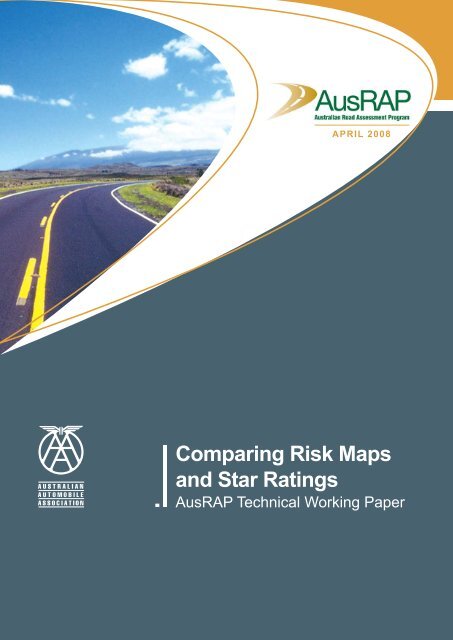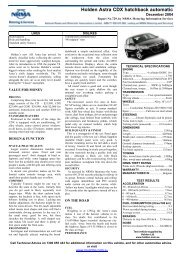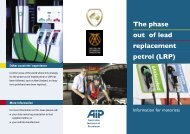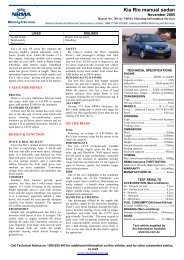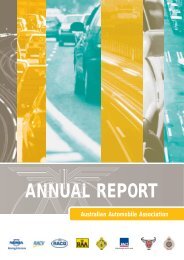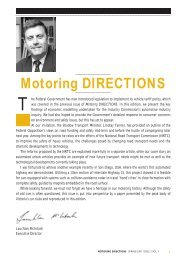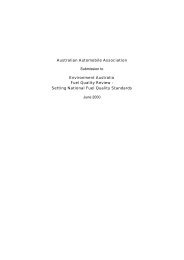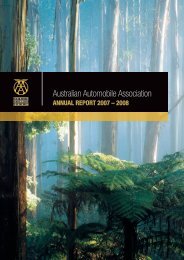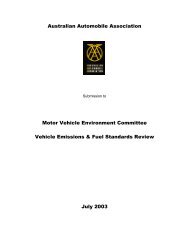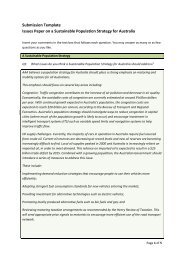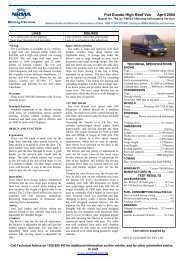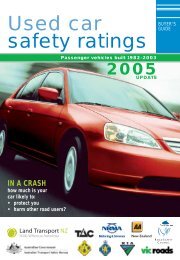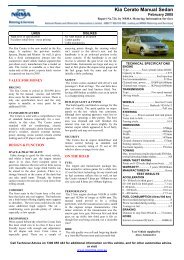Comparing Risk Maps and Star Ratings - Australian Automobile ...
Comparing Risk Maps and Star Ratings - Australian Automobile ...
Comparing Risk Maps and Star Ratings - Australian Automobile ...
You also want an ePaper? Increase the reach of your titles
YUMPU automatically turns print PDFs into web optimized ePapers that Google loves.
APRIL 2008<strong>Comparing</strong> <strong>Risk</strong> <strong>Maps</strong><strong>and</strong> <strong>Star</strong> <strong>Ratings</strong>AusRAP Technical Working Paper
1<strong>Comparing</strong> <strong>Risk</strong> <strong>Maps</strong> <strong>and</strong> <strong>Star</strong> <strong>Ratings</strong>About this reportSince 2004, the <strong>Australian</strong> <strong>Automobile</strong> Association (AAA) has released a number ofreports rating highways for risk using two protocols: <strong>Risk</strong> Mapping <strong>and</strong> <strong>Star</strong> <strong>Ratings</strong>.These reports can be viewed at www.ausrap.org.AAA commissioned ARRB Group to investigate the relationship between the twoprotocols. This report presents the findings of that research, which was undertaken byRob McInerney, Jarrod Harkness, Joseph Affum <strong>and</strong> Kerry Armstrong (ARRB) underthe direction of John Metcalfe <strong>and</strong> Greg Smith (AAA).Contact detailsFor more information or copies of AusRAP reports or DVD, contact:<strong>Australian</strong> <strong>Automobile</strong> Association216 Northbourne AvenueCanberra ACT 2601Email: aaa@aaa.asn.auWeb: www.aaa.asn.auPhone: +61 2 6247 7311Or visit: www.ausrap.orgMaterial in the publication maybe reproduced or quoted provided AAA <strong>and</strong> the Authorsare acknowledged.April 2008.AcknowledgementsThe <strong>Australian</strong> <strong>Automobile</strong> Association acknowledges the <strong>Australian</strong> Government’sfinancial support for AusRAP through the <strong>Australian</strong> Transport Safety Bureau.The Road <strong>and</strong> Traffic Authorities in the States <strong>and</strong> Territories provided data, software<strong>and</strong> technical support for the program.Although the Report is believed to be correct at the time of publication, ARRB Group Ltd, to the extent lawful, excludes all liability for loss(whether arising under contract, tort, statute or otherwise) arising from the contents of the Report or from its use. Where such liabilitycannot be excluded, it is reduced to the full extent lawful. Without limiting the foregoing, people should apply their own skill <strong>and</strong>judgement when using the information contained in the Report.www.arrb.com.au
2SummaryThe AusRAP <strong>Star</strong> <strong>Ratings</strong> initiative was launched by the <strong>Australian</strong> <strong>Automobile</strong>Association in October 2006 following over two years of research, development <strong>and</strong>assessment. The <strong>Star</strong> Rating results are based on an assessment of the engineeringfeatures of the road network <strong>and</strong> the calculation of a Road Protection Score (RPS).This report details an investigation into the relationship between the <strong>Star</strong> <strong>Ratings</strong> / RPS<strong>and</strong> the crash costs on the road network. While the AusRAP model is not a crashprediction tool a link between the <strong>Star</strong> <strong>Ratings</strong> / RPS <strong>and</strong> crash outcomes is expected.The study involved the comparison of crash data <strong>and</strong> <strong>Star</strong> Rating / RPS results on theQueensl<strong>and</strong> AusLink network assessed as part of the 2006 report. The primaryanalysis of average crash costs per vehicle kilometre travelled <strong>and</strong> the <strong>Star</strong> <strong>Ratings</strong>revealed the following result:average crash costs of $0.027 per vehicle kilometre travelled on 4 star roads;average crash costs of $0.050 per vehicle kilometre travelled on 3 star roads; <strong>and</strong>average crash costs of $0.101 per vehicle kilometre travelled on 2 star roads.$0.120$0.100Crash cost per VKT$0.080$0.060$0.040$0.050$0.101$0.020$0.027$0.00014 23 23<strong>Star</strong> RatingThe analysis provides a strong indication of the improvement in crash costs that can beexpected as a road network improves from two star to three star to four star <strong>and</strong>ultimately a five star road. These results are expected to assist in further work beingundertaken during 2007/2008 to investigate the expected economic costs <strong>and</strong> benefitsof raising the AusLink network to a four star st<strong>and</strong>ard.www.arrb.com.au
3Contents1 Introduction....................................................................................................41.1 Road Protection Score...........................................................................62 Research Philosophy ....................................................................................72.1 Research Methodology..........................................................................73 Research Outcomes .................................................................................... 103.1 Crash cost per vehicle kilometre travelled by <strong>Star</strong> Rating.................... 113.2 Crash cost per vehicle kilometre travelled by raw RPS........................ 133.3 Component RPS.................................................................................. 153.3.1 Run-off road RPS ........................................................................... 163.3.2 Head-on RPS ................................................................................. 183.3.3 Intersection RPS............................................................................. 204 Conclusion ................................................................................................... 225 References ................................................................................................... 23Appendix A Cumulative VKT vs Crash Cost per VKT Charts .................... 24Appendix B Alternate Research Methodologies............................................. 27www.arrb.com.au
41 IntroductionThe <strong>Australian</strong> Road Assessment Program (AusRAP) is a sister program to theAustralasian New Car Assessment Program (ANCAP), which crash-tests new cars <strong>and</strong>awards them stars for safety. AusRAP is based on the European equivalent, EuroRAPwhich produces maps showing the risk of road crashes that cause death <strong>and</strong> lifethreateninginjury <strong>and</strong> rates roads for safety. It highlights improvements that could bemade to roads to reduce the likelihood of crashes — <strong>and</strong> to make those that do happensurvivable.AusRAP uses two methods — or protocols — to assess the safety of roads. AusRAP’sfirst protocol, <strong>Risk</strong> Mapping, is based on a road’s history of casualty crashes <strong>and</strong> trafficvolume. Previous AusRAP reports, released in 2004 <strong>and</strong> 2005, used risk-maps toprovide a measure of the safety performance of the AusLink National Network. Roadcrash fatalities on the AusLink network account for around 15 per cent of annual roadfatalities in Australia.The first AusRAP <strong>Star</strong> <strong>Ratings</strong> report was published in October 2006. The <strong>Star</strong> <strong>Ratings</strong>involve an inspection of a number of design elements such as lane <strong>and</strong> shoulder width<strong>and</strong> the presence of safety barriers, which are known to have an impact on thelikelihood of a crash <strong>and</strong> its severity. Between one <strong>and</strong> five stars are awarded to roadlinks depending on the level of safety which is ‘built-in’ to the road. The <strong>Star</strong> <strong>Ratings</strong> donot take into account a road’s crash history.The first report provided <strong>Star</strong> <strong>Ratings</strong> (from one star to five star) of the <strong>Australian</strong>AusLink network in all States <strong>and</strong> Territories except NSW <strong>and</strong> involved the assessment<strong>and</strong> rating of over 18,300 kilometres of road. In summary 2% of the network was ratedtwo star, 51% of the network was rated three star <strong>and</strong> 47% of the network was ratedfour star.In September 2007, a second report was published which included <strong>Star</strong> <strong>Ratings</strong> for theAusLink Network in NSW, which previously was not able to be rated. This took the totallength of the rated AusLink network to 22,969km. The addition of the NSW ratingsresulted in 3% of the network being rated two star, 55% rated three star <strong>and</strong> 42% ratedfour star.www.arrb.com.au
5State highways in Victoria, Western Australia <strong>and</strong> Queensl<strong>and</strong> have also been <strong>Star</strong>Rated by the RACV, RACWA <strong>and</strong> RACQ respectively.Following the release of the various reports, significant interest was generated into theextent of the relationship between the <strong>Star</strong> <strong>Ratings</strong> <strong>and</strong> <strong>Risk</strong> <strong>Maps</strong>. The obviousquestion was raised as to whether high risk roads identified in the <strong>Risk</strong> Mappingprotocol correspond with high risk roads in the <strong>Star</strong> Rating protocol.This AusRAP Technical Working Paper addresses this question by comparing therelationship between <strong>Risk</strong> <strong>Maps</strong> <strong>and</strong> <strong>Star</strong> <strong>Ratings</strong>. This analysis is based on researchundertaken by ARRB for AAA. ARRB investigated different methodologies forresearching this relationship <strong>and</strong> determined that crash costs, as opposed to <strong>Risk</strong><strong>Maps</strong> per se, was the most appropriate measure for the comparison.www.arrb.com.au
61.1 Road Protection Score<strong>Star</strong> <strong>Ratings</strong> are based on a Road Protection Score (RPS) that measures the inherentsafety of the road network as it relates to an individual road user. The RPS is based onthree component measures that address the predominant crashes on open rural roads,namely:run-off road;head-on; <strong>and</strong>intersection.A RPS is determined for each component <strong>and</strong> a total RPS is then calculated fromthese individual components. The RPS that determines the the <strong>Star</strong> Rating (one to five)<strong>and</strong> the typical roads represented by those ratings is detailed in Table 1 below.Table 1RPS <strong>and</strong> <strong>Star</strong> Rating levelsRPS ScoreRating Scale< 1.05 *****Divided RoadStraight with good line-marking,wide lanes <strong>and</strong> sealed shoulders,forgiving roadside <strong>and</strong> over- orunder-pass intersections.Typical roadUndivided RoadNo undivided roads can achieve a5-<strong>Star</strong> Rating.1.05-
72 Research PhilosophyThe RPS is independent of traffic volume. This reflects the primary focus of theAusRAP <strong>Star</strong> <strong>Ratings</strong> on the safety of the infrastructure elements of the road <strong>and</strong> theimpact of the road on an individual road user. The RPS model also accounts for boththe likelihood <strong>and</strong> severity of a crash event.Since the RPS relates to individual risk, it might be expected that there is a relationshipbetween RPS <strong>and</strong> the measure of individual risk (crashes per vehicle kilometretravelled (VKT)) used for the <strong>Risk</strong> <strong>Maps</strong>.We argue that the most appropriate means of testing the relationship is to convert theindividual risk component of <strong>Risk</strong> Mapping to crash costs per vehicle kilometretravelled. The use of crash costs accounts for both the number <strong>and</strong> severity of crashesas relevant to an individual on the road.Knowledge of the relationship between the RPS <strong>and</strong> actual crash costs per vehiclekilometre travelled is important for two reasons:1. As a form of model validation, it is expected that the crash costs per vehiclekilometre travelled will increase on roads with a lower <strong>Star</strong> Rating (that is, ahigher RPS). For example, we would expect that (after adjusting for trafficvolume) a road with a one or two <strong>Star</strong> Rating to have more crashes than a roadwith a three or four <strong>Star</strong> Rating.It should be emphasised however, that the AusRAP RPS model is not intendedto be a crash prediction model. This is primarily because the model considersrisk to an individual road user independent of exposure effects; intersection riskis modified slightly to measure quality relative to a best case condition; <strong>and</strong> theassessment technique involves the averaging of conditions over homogeneoussections.2. To provide a knowledge of the crash cost savings that can be achieved throughimprovements in road infrastructure. This will allow clubs <strong>and</strong> authorities tounderst<strong>and</strong> the economic benefits to be achieved from improving the <strong>Star</strong>Rating of roads.2.1 Research MethodologyFor the purpose of the RPS <strong>and</strong> crash cost study, we used Queensl<strong>and</strong> data toexamine the relationship. This choice was made because of data availability <strong>and</strong> theextent of the road network (over 5,300 carriageway kilometres of road – refer to Figure1 on page 9). An added advantage was the use of earlier video data (2003-2004) inthe rating of the Queensl<strong>and</strong> road network, since the data for this period will moreaccurately reflect the conditions that existed during the period over which the crashdata has been sourced (1999-2004) 1 .1 It is noted that changes to the network may have occurred throughout the crash period. TheAusRAP model cannot account for those changes as it relates to a snap-shot at a point in time.It is expected that those secions where changes have occurred are relatively small in lengthcompared with the overall length of the network.www.arrb.com.au
8The tasks involved in the project included the following: Source traffic volume <strong>and</strong> crash data over the study period from 1999 to 2004.Assign crash <strong>and</strong> traffic data to each relevant homogeneous section identifiedduring the rating of the Queensl<strong>and</strong> network. This was based on the raw RPSresults. Source crash cost data for use in the research <strong>and</strong> calculate the estimatedcrash costs for each section of road.Calculate the vehicle kilometres travelled for each road section.Calculate the crash cost per vehicle kilometre for each road section.Analyse <strong>and</strong> review the relationships identified.The research activity involved the consideration of different methodologies prior toadopting the final approach described in the main body of this report. The finalapproach was selected following discussions with the EuroRAP research team <strong>and</strong> theoutcomes of similar analyses being undertaken on the EuroRAP results. Furtherdetails on the non-preferred approaches are provided in Appendix B.www.arrb.com.au
9Figure 1Queensl<strong>and</strong> <strong>Star</strong> <strong>Ratings</strong> based on 2003/04 video dataWEIPACAIRNSINNISFAILINGHAMROAD PROTECTION SCORE***************BARKLY HWYCAMOOWEALCLONCURRYMOUNT ISAFLINDERS HWYRICHMONDTOWNSVILLEAYRMINGELACHARTERS TOWNERSPROSERPINEHUGHENDENMACKAYLANDSBOROUGH HWYKYNUNAWINTONBRUCE HWYLONGREACHBARCALDINEROCKHAMPTONGLADSTONEBLACKALLTAMBOGIN GIN0MARYBOROUGHAUGATHELLAGYMPIEROMAMORVENCHINCHILLAWAREGO HWYBRISBANETOOWOOMBAIPSWICHS.E. FREEWAY200 400 GORE HWYGOLD COASTWARWICKkilometresGOONDIWINDICUNNINGHAM HWYNEW ENGLAND HWYwww.arrb.com.au
103 Research OutcomesThe first stage of the project involved the sourcing of volume data for the Queensl<strong>and</strong>road network <strong>and</strong> for each homogeneous section defined in the AusRAP <strong>Star</strong> <strong>Ratings</strong>.The next stage involved obtaining crash data for the six years from 1999 to 2004 forthe network. For the purpose of this evaluation, the severity outcome of the crash wascritical to ensure that the crash costs were based on actual outcomes <strong>and</strong> not averageoutcomes (e.g. fatal crash as opposed to average crash costs by crash type).The crash severity costs were based on those used by Queensl<strong>and</strong> Main Roads.Table 2 QDMR crash costs 1Fatal Crash $ 2,038,182Serious Injury Crash $ 500,741Minor Injury Crash $ 29,5981 It is noted that a range of alternative values are available for the average crash costseverity (e.g. BTRE, ARRB). The QDMR figures were selected as the analysis isbased solely on Queensl<strong>and</strong> data.Based on this information, the crash data was assigned to the relevant AusRAPhomogeneous sections <strong>and</strong> the crash cost per VKT was calculated.The data was then aggregated by the <strong>Star</strong> Rating calculated for that road section aspart of the AusRAP assessment. All assessments were based on the <strong>Star</strong> Rating foreach smaller homogeneous section (typically 200m – 20km) <strong>and</strong> not the longer lengths(>50km) presented in the final results. This allowed for greater sensitivity <strong>and</strong> changesin condition to be reflected in the analysis.Further analysis was then conducted to compare the component RPS with each of thethree component crash costs (that is, run-off road, head-on <strong>and</strong> intersection). Wherepossible, the RPS ranges were selected to ensure each one included a reasonablesize sample of road (with a target minimum of approximately 100km of road length).The results of the analyses undertaken are detailed in the sections below:Crash cost per VKT by <strong>Star</strong> RatingCrash cost per VKT by raw RPSComponent RPS – run-off road RPSComponent RPS – head-on RPSComponent RPS – intersection RPSwww.arrb.com.au
113.1 Crash cost per vehicle kilometre travelled by <strong>Star</strong> RatingFigure 2 shows the crash cost per VKT by <strong>Star</strong> Rating. The results show that a lower<strong>Star</strong> Rating is associated with a higher crash cost per VKT. The average crash cost isthree cents per vehicle kilometre on a four star road; five cents per vehicle kilometre ona three star road <strong>and</strong> ten cents per vehicle kilometre on a two star road.Figure 2Crash cost per VKT by <strong>Star</strong> Rating$0.120$0.100Crash cost per VKT$0.080$0.060$0.040$0.050$0.101$0.020$0.027$0.00014 23 23<strong>Star</strong> RatingThe detailed results are provided in Table 3 below.Table 3Crash cost per VKT by <strong>Star</strong> RatingRPS<strong>Star</strong>B<strong>and</strong>NumberofRecordsLength ofRoad (km)Annual VKTAnnual CrashCost ($)Crash Cost perVKT ($)1.05 to 4 4 237 2244 5,300,987,000 $ 144,814,332 $ 0.0274 to 10 3 324 2713 3,453,578,692 $ 173,576,162 $ 0.05010 to 25 2 24 101 223,384,620 $ 22,470,566 $ 0.101Note: insufficient / no data available for one <strong>and</strong> five star sections. Refer to Appendix A for the distributionof individual section results in relation to cumulative vehicle kilometres travelled.www.arrb.com.au
12A detailed review of the results highlighted a wide spread in actual crash costs for eachsmall homogeneous section. This is to be expected as there are many short sectionsof road where no crashes have occurred (zero crash costs) <strong>and</strong> the increase in crashcosts from this type of location to one where a single fatal crash may have occurred, issignificant. To demonstrate this effect, the cumulative distribution curve for each <strong>Star</strong>Rating in relation to the length of road within each <strong>Star</strong> Rating b<strong>and</strong> was generated <strong>and</strong>is provided in Figure 3.Figure 3per VKTDistribution of homogeneous sections by <strong>Star</strong> B<strong>and</strong> <strong>and</strong> crash cost<strong>Star</strong> B<strong>and</strong> Cumulative Length vs Crash Cost per VKT100%Cumulative Length %80%60%40%20%4 <strong>Star</strong>3 <strong>Star</strong>2 <strong>Star</strong>0%$0.00 $0.02 $0.04 $0.06 $0.08 $0.10 $0.12 $0.14 $0.16 $0.18 $0.20Crash Cost Per VKTThe distribution curves reflect a higher proportion of four star road sections with zerocrash costs compared to two <strong>and</strong> three-star roads. The two-star roads clearly have ahigher proportion of road sections with higher crash costs than the three <strong>and</strong> four-starsections of road. Ideally the four-star curve should track above the three-star curve forthe full distribution (up to 100%), although the results see the three-star distribution(yellow) cross the four-star distribution at approximately 14 cents per VKT.In reviewing these results, it is important to consider the step-based nature of the <strong>Star</strong><strong>Ratings</strong>, such that some roads have RPS values close to the cut-off for a particularb<strong>and</strong>. This may help explain the crossover of the three <strong>and</strong> four star-curves at 14cents per VKT as some of the three <strong>and</strong> four-star sections will have an RPS close tothe three/four star cut-off value.www.arrb.com.au
The following section compares each of the individual component RPS values againstthe crash costs per VKT for crashes related to that component. The aim of this was todetermine if a particular component was responsible for the trends seen in Figures 3<strong>and</strong> 5, or whether the results are a combination of all three component risks (run-off,head-on <strong>and</strong> intersection).163.3.1 Run-off road RPSThe run-off road RPS was grouped into ranges <strong>and</strong> the crash costs associated withrun-off road crashes only were determined for each homogeneous section. The resultsof the analysis are detailed in Figure 6 <strong>and</strong> Table 6 below.Figure 6Run-off road crash cost per VKT by run-off RPS$0.025$0.020$0.022Run off crash cost per VKT$0.015$0.010$0.005$0.009$0.017$0.019$0.0000 to 2 2 to 4 4 to 6 6 to 10Run off RPSFigure 6 shows the run-off road crash cost per VKT by run-off road RPS. The figureindicates an increasing trend in run-off road crash costs per VKT as the run-off roadRPS increases. The analysis has identified that the average run-off road crash cost forrun-off road RPS scores between zero <strong>and</strong> two is 0.9 cents per vehicle kilometretravelled; between two <strong>and</strong> four is 1.7 cents per vehicle kilometre travelled; betweenfour <strong>and</strong> six is 1.9 cents per vehicle kilometre travelled; <strong>and</strong> between six <strong>and</strong> ten is 2.2cents per vehicle kilometre travelled (see Table 6).www.arrb.com.au
17Table 6Run-off road crash cost per VKT by run-off RPSRPSNumberofRecordsLength ofRoad (km)Annual VKTAnnual CrashCost ($)Crash Costper VKT ($)0 to 2 144 822 1,948,267,212 $ 17,535,521 $ 0.0092 to 4 361 3664 5,180,347,280 $ 89,784,566 $ 0.0174 to 6 57 395 1,394,025,350 $ 26,374,511 $ 0.0196 to 10 26 179 485,845,979 $ 10,688,673 $ 0.022Note: refer to Appendix A for the distribution of individual section results in relation to cumulative vehiclekilometres travelled.The distribution of results in relation to road length is detailed in Figure 7 below. Theresults generally indicate:a higher proportion of road length with no run-off road crashes on roads withlower run-off road RPS; <strong>and</strong>the higher run-off road crash costs are experienced on the roads with a higherrun-off road RPS.Figure 7Distribution of homogeneous sections by run-off road RPS <strong>and</strong>run-off road crash cost per VKTRun Off RPS Cumulative Length vs Run Off Crash Cost per VKT100%Cumulative Length %80%60%40%20%Run OffRPS 0 to 2Run OffRPS 2 to 4Run OffRPS 4 to 6Run OffRPS 6 to 100%$0.00 $0.01 $0.02 $0.03 $0.04 $0.05 $0.06 $0.07 $0.08 $0.09 $0.10Run Off Crash Cost Per VKTThe distributions for run-off road RPS scores between two <strong>and</strong> ten (black, red <strong>and</strong>yellow) do intersect with each other, making the distinction between the distributionsless obvious. A stronger link might have been expected although the result mayhighlight the specific difficulty in rating roadside hazards <strong>and</strong> the highly variableoutcomes that may occur when vehicles run-off the road. A review of the modeloutcomes suggested the following: Run-off road RPS scores of zero to two are typically locations where nohazards exist <strong>and</strong> where crashes are not likely to involve serious injury. Theselocations can be rated consistently.www.arrb.com.au
18Run-off road RPS scores of two <strong>and</strong> above are generally present when there issome form of hazard in the roadside <strong>and</strong> the outcome of an errant vehicle maybe impacted more by the exact location of the run-off road crash <strong>and</strong> thecircumstances of the crash (e.g. did the vehicle roll, vehicle type, seat-belts <strong>and</strong>exactly where a vehicle struck an object).AusRAP has recently decided to make changes to the <strong>Star</strong> Rating model which areexpected to better define roadside hazards in relation to run-off road RPS. Thesechanges include a move from homogeneous rating to continuous rating 2 <strong>and</strong> theinclusion of a specific rating category for steel safety barriers. A review of therelationship between any adjusted RPS <strong>and</strong> crash costs is recommended following anysubsequent rating of the AusLink networks.3.3.2 Head-on RPSThe head-on road RPS was grouped into ranges <strong>and</strong> the crash costs associated withhead-on road crashes only were determined for each homogeneous section. Theresults of the analysis are detailed in Figures 8 <strong>and</strong> Table 7 below.Figure 8Head-on crash cost per VKT by head-on RPS$0.018$0.016Head on crash cost per VKT$0.014$0.012$0.010$0.008$0.006$0.004$0.016$0.017$0.013$0.002$0.0008 to 11 11 to 13 13 to 17Head on RPSThere were no roads in the 0 to 8 category as the minimum score possible for head-onRPS is greater than 8.2. It is noted that the head-on RPS equals zero for dividedcarriageway roads.The head-on RPS category between 13 <strong>and</strong> 17 is expected to exhibit the highest headoncrash cost per vehicle kilometre travelled. However, the results indicate that the2 The homogeneous rating method requires raters to segregate roads into sections that are ofconsistent design along their length (eg all divided). These sections are then individually rated.The continuous rating approach means roads are simply segregated at 100m intervals <strong>and</strong> thenthese short sections are rated separately. This continuous rating method is likely to producemore reliable <strong>and</strong> repeatable ratings than the homogeneous method.www.arrb.com.au
lowest head-on crash cost per vehicle kilometre travelled was recorded on sites withthe worst head-on RPS.Following this result the individual records for each homogeneous section werereviewed to identify a possible explanation for this relationship. It was discovered thatroads in the 13 to 17 range for head-on RPS typically had poor alignment with poorovertaking opportunities <strong>and</strong> medium to high volume. Therefore a possible explanationcould be that overtaking facilities are so poor that motorists do not attempt to overtake<strong>and</strong> therefore the head-on crash cost is less than expected. This outcome requiresreview in relation to the desired purpose of the AusRAP model (as a communicationtool <strong>and</strong> not a crash prediction tool), <strong>and</strong> whether changes in the model are warranted.19Table 7Head-on crash cost per VKT by head-on RPSRPSNumberofRecordsLength ofRoad (km)Annual VKTAnnual CrashCost ($)Crash Costper VKT ($)8 to 11 80 568 416,637,677 $ 6,483,962 $ 0.01611 to 13 366 3599 2,588,833,291 $ 45,140,143 $ 0.01713 to 17 36 221 190,192,595 $ 2,484,532 $ 0.013Note: refer to Appendix A for the distribution of individual section results in relation to cumulative vehiclekilometres travelled.In terms of the length of road within the various RPS categories (refer Figure 9), thelowest head-on RPS range of 8 to 11 exhibited the highest proportion of road length(approximately 60%) where no head-on crashes were observed (refer figure 8 below).With significant sections with no head-on crash costs the results are heavily influencedby the magnitude of crash costs per VKT occurring on a relative low proportion of thelength (<strong>and</strong> cumulative VKT). Locations accounting for 3% of the VKT accounted for25% of the crash costs per VKT for the RPS range. As a result, the distributions – <strong>and</strong>thus the general result - can alter significantly with only a relatively small change in thenumber of head-on crashes.Figure 9Distribution of homogeneous sections by head-on RPS <strong>and</strong> headoncrash cost per VKTHead On RPS Cumulative Length vs Head On Crash Cost per VKT100%Cumulative Length %80%60%40%20%Head on RPS8 to 11Head on RPS11 to 13Head on RPS13 to 170%$0.00 $0.01 $0.02 $0.03 $0.04 $0.05 $0.06 $0.07 $0.08 $0.09 $0.10Head on Crash Cost Per VKTwww.arrb.com.au
203.3.3 Intersection RPSFor the purpose of this study the intersection RPS refers to the total RPS attributable tointersections within a homogeneous section. That is, they are not individualintersection RPS values but the collective intersection RPS within each homogeneoussection. This RPS is then related to the sum total of intersection crash costs within thehomogeneous section being considered.Figure 10 shows the intersection crash cost per VKT by intersection RPS. The graphshows that as the intersection RPS increases the intersection crash cost per VKT alsoincreases.Figure 10Intersection crash cost per VKT by intersection RPS$0.025Intersection crash cost per VKT$0.020$0.015$0.010$0.005$0.006$0.008$0.009$0.016$0.022$0.0000 to 1 1 to 2 2 to 3 3 to 4 4 to 16Intersection RPSThe detailed results are provided in Table 8 below.Table 8Intersection crash cost per VKT by intersection RPSRPSNumberofRecordsLength ofRoad (km)Annual VKTAnnual CrashCost ($)Crash Costper VKT ($)0 to 1 161 1986 3,501,188,368 $ 22,165,489 $ 0.0061 to 2 89 711 1,256,232,331 $ 10,139,384 $ 0.0082 to 3 56 337 576,319,778 $ 5,212,877 $ 0.0093 to 4 35 185 432,437,111 $ 6,741,639 $ 0.0164 to 16 38 173 352,863,102 $ 7,873,784 $ 0.022Note: refer to Appendix A for the distribution of individual section results in relation to cumulative vehiclekilometres travelled.www.arrb.com.au
21The general shape of the cumulative distributions (see Figure 11) align withexpectations with a higher proportion of road sections with no intersection crashes(zero cost) on road sections with lower intersection RPS values. In general, the roadsections with higher RPS contributions from intersections experienced higherintersection crash costs.Figure 11Distribution of homogeneous sections by intersection RPS <strong>and</strong>intersection crash cost per VKTIntersection RPS Cumulative Length vs Intersection Crash Cost per VKT100%Cumulative Length %80%60%40%20%IntersectionRPS 0 to 1IntersectionRPS 1 to 2IntersectionRPS 2 to 3IntersectionRPS 3 to 4IntersectionRPS 4 to 160%$0.00 $0.01 $0.02 $0.03 $0.04 $0.05 $0.06 $0.07 $0.08 $0.09 $0.10Intersection Crash Cost Per VKTwww.arrb.com.au
235 ReferencesMcInerney, R., Affum, J., Callaghan, L., Taylor, S., Wix, R., Hansen, L. <strong>and</strong> Barlow, S.(2006) AusRAP <strong>Star</strong> Rating <strong>and</strong> Road Protection Score Methodology (QC71711 -Report 3), ARRB Group Brisbane.Metcalfe, J. <strong>and</strong> Smith, G. (October 2006). <strong>Star</strong> <strong>Ratings</strong>: Australia’s National Networkof Roads, <strong>Australian</strong> <strong>Automobile</strong> Association, Canberra.Metcalfe, J. <strong>and</strong> Smith, G. (October 2006). Safer Roads Save Lives: <strong>Star</strong> <strong>Ratings</strong> ForThe AusLink National Network in NSW, <strong>Australian</strong> <strong>Automobile</strong> Association, Canberra.Metcalfe, J. <strong>and</strong> Smith, G. (March 2005). How safe are our roads? Rating Australia’sNational Highways for <strong>Risk</strong>, <strong>Australian</strong> <strong>Automobile</strong> Association, Canberra.Metcalfe, J. <strong>and</strong> Smith, G. (November 2005). How safe are our roads? RatingAustralia’s National Network for <strong>Risk</strong>, <strong>Australian</strong> <strong>Automobile</strong> Association, Canberra.Metcalfe, J. <strong>and</strong> Smith, G. (July 2007). How safe are our roads? Rating Australia’sNational Network for <strong>Risk</strong>, <strong>Australian</strong> <strong>Automobile</strong> Association, Canberra.www.arrb.com.au
24Appendix ACumulative VKT vs Crash Cost per VKT ChartsFigure A1<strong>Star</strong> Rating cumulative VKT vs crash cost per VKT<strong>Star</strong> B<strong>and</strong> Cumulative VKT vs Crash Cost per VKT100%80%Cumulative VKT %60%40%20%4 <strong>Star</strong>3 <strong>Star</strong>2 <strong>Star</strong>0%$0.00 $0.02 $0.04 $0.06 $0.08 $0.10 $0.12 $0.14 $0.16 $0.18 $0.20Crash Cost Per VKTFigure A2RPS cumulative VKT vs crash cost per VKTRPS Cumulative VKT vs Crash Cost per VKT100%Cumulative VKT %80%60%40%20%RPS 0 to 2RPS 2 to 4RPS 4 to 6RPS 6 to 8RPS 8 to 10RPS 10 to 250%$0.00 $0.02 $0.04 $0.06 $0.08 $0.10 $0.12 $0.14 $0.16 $0.18 $0.20Crash Cost Per VKTwww.arrb.com.au
25Figure A3Run-off road RPS cumulative VKT vs run-off road crash cost perVKTRun Off RPS Cumulative VKT vs Run Off Crash Cost per VKT100%Cumulative VKT %80%60%40%20%Run OffRPS 0 to 2Run OffRPS 2 to 4Run OffRPS 4 to 6Run OffRPS 6 to 100%$0.00 $0.01 $0.02 $0.03 $0.04 $0.05 $0.06 $0.07 $0.08 $0.09 $0.10Run Off Crash Cost Per VKTFigure A4Head-on RPS cumulative VKT vs head-on crash cost per VKTHead On RPS Cumulative VKT vs Head On Crash Cost per VKT100%Cumulative VKT %80%60%40%20%Head on RPS8 to 11Head on RPS11 to 13Head on RPS13 to 170%$0.00 $0.01 $0.02 $0.03 $0.04 $0.05 $0.06 $0.07 $0.08 $0.09 $0.10Head on Crash Cost Per VKTwww.arrb.com.au
26Figure A5Intersection RPS cumulative VKT vs intersection crash cost perVKTIntersection RPS Cumulative VKT vs Intersection Crash Cost per VKT100%Cumulative VKT %80%60%40%20%IntersectionRPS 0 to 1IntersectionRPS 1 to 2IntersectionRPS 2 to 3IntersectionRPS 3 to 4IntersectionRPS 4 to 160%$0.00 $0.01 $0.02 $0.03 $0.04 $0.05 $0.06 $0.07 $0.08 $0.09 $0.10Intersection Crash Cost Per VKTwww.arrb.com.au
27Appendix BAlternate Research MethodologiesThe ARRB research team undertook a detailed regression analysis to investigate thedirect relationship (if any) between the RPS <strong>and</strong> crash costs. The approach focusedon examining the relationship between RPS <strong>and</strong> crash costs per vehicle-kilometretravelled (VKT). This is based on the notion that any relationship between the RPS<strong>and</strong> crash outcomes is expected to be with crash costs per vehicle kilometre travelledas it accounts for both the number <strong>and</strong> severity of crashes as relevant to an individualroad user.The analysis was undertaken on the data-set described in Section 2 of the report. Theinitial investigation focussed on the direct relationships between the raw RPS scores<strong>and</strong> crash costs per vehicle kilometre travelled on each homogeneous section. Thescatterplot of the results is detailed in Figure B1 below.Figure B1Relationship between cost of crashes per VKT <strong>and</strong> RPS (full dataset)RPS v Crash Cost per VKT Scatter Plot$1.60$1.40Crash Cost per VKT$1.20$1.00$0.80$0.60$0.40$0.20$-0 2 4 6 8 10 12 14 16 18 20RPSwww.arrb.com.au
28A closer examination of the data adjusting the Y-axis to a maximum crash cost per VKTof $0.40 is detailed in Figure B2.Figure B2Relationship between cost of crashes per VKT <strong>and</strong> RPS (part dataset)RPS v Crash Cost per VKT Scatter Plot$0.40$0.35Crash Cost per VKT$0.30$0.25$0.20$0.15$0.10$0.05$-0 2 4 6 8 10 12 14 16 18 20RPSA regression analysis on the data set was deemed inappropriate as there is a widevariation in the actual results from road section to section. This reflects the true natureof a crash event as a r<strong>and</strong>om multi-variable infrequent event. There is also a largenumber of individual sections where there is no crash history <strong>and</strong> as a result there iszero crash costs per VKT.The project team reviewed the methodology following discussions with the EuroRAPteams where the approach has been to compare crash costs <strong>and</strong> RPS results overlarger aggregated samples (such as the <strong>Star</strong> Rating b<strong>and</strong>s). This approach forms thebasis of the main body of this report. The cumulative distribution charts were added tothe analysis to demonstrate the range of crash cost outcomes evident within eachrange of RPS values.www.arrb.com.au


